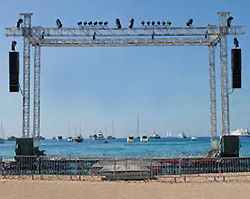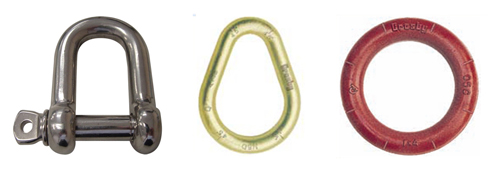
Stress Effects Of Reeving
Reeving is when a Spanset, nylon strap, wire rope, or other suspension part that’s already fastened to an attachment point is then passed through a shackle, an eyebolt, a handle, or some other fitting, and then is fastened to a third attachment point.
It’s common to see reeving in all manner of rigs ranging from small club systems to large PA hangs.
For reasons unknown, people just like to do this. I’ve overheard talk in which the reckless reever believes it’s actually safer to do so. I did it once or twice myself, before I understood the stress effects.
What happens with reeving is a lot like a 90-degree bridle. The force on the reeved part, as well as the shackles and the other fittings associated with the reeve, is magnified many times over to the point where it can damage otherwise perfectly constructed materials and weldments in a fly frame. The compression force on the object, be it a loudspeaker, a rigging frame, or other, will be many times that of the object’s actual weight.
Additionally, the load can rotate or shift within the reeve, increasing the stress yet again when the load shifts – very possibly leading to sudden failure. Therefore don’t do it!
The only arguable reason might be to “use up” an excessive length of a Spanset or wire rope sling, in order to shorten the distance to the upper attachment point(s) when headroom is limited. Sorry, that’s not an acceptable reason. Obtain the proper length of wire rope slings or Spansets. Again, do not reeve!
Now, just so I don’t get letters from irate construction workers, reeving does have a place in the construction industry. If you reeve the attachment fittings on a 100-ton water valve, you can use your crew to shift the valve within the cradle created by the reeve to align it with the 80-inch pipe you’re fitting it to.
But please note that when this takes place, it does not occur over people’s heads. And it usually doesn’t last for more than a few moments of work in a restricted-access construction zone with trained personnel. Neither of the aforementioned conditions typically prevail in an entertainment technology rigging setting.

Straight & Lateral
A frequently asked question: do pairing rings always come in pairs (like earrings)? No. You can buy them one at a time. In the previous installment, I harped on the fact that shackles are not pairing rings (Figure 4); in other words you should not use a shackle to join two bridle parts together, unless the bridle angle is very shallow and the shackle is rated for limited “pairing” use.
So instead, you’ll want to carry a selection of pairing rings in your rigging kit. A pairing ring is intended to take lateral forces in addition to a straight line force. Like anything else, it too has its limitations. You can’t pull it in all directions at once; if you need to do that, you’ll want a Weldless Circular Ring, such as the one shown above, which is also easy to obtain from any good industrial supplier.
And when using either a pairing ring or a circular ring, simply attach the shackles to the ring. In both cases, you’ve avoided placing lateral loads on the shackles themselves. Now it’s all good.
While we’ve conquered many things once deemed impossible but now takenf or granted – such as air transport, wireless communication, modern PA systems of amazing quality, and much, much more – let not our quest for pure technology overshadow our intrinsic responsibility to our community.
Be it a rock concert or a political rally, we need to be able to say, “Everyone gets to go home safely.”
Ken DeLoria is the founder and former owner of Apogee Sound, a manufacturer of loudspeakers and many associated rigging accessories. For more than 30 years, he has been a sound engineer, a hands-on rigger, and a safety supervisor at numerous events and permanent installations.
